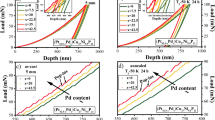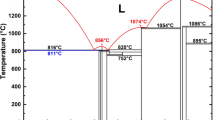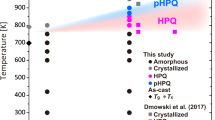Abstract
A metal, or an alloy, can often exist in more than one crystal structure. The face-centred-cubic and body-centred-cubic forms of iron (or steel) are a familiar example of such polymorphism. When metallic materials are made in the amorphous form, is a parallel ‘polyamorphism’ possible? So far, polyamorphic phase transitions1,2,3,4,5,6,7 in the glassy state have been observed only in glasses involving directional and open (such as tetrahedral4,5) coordination environments. Here, we report an in situX-ray diffraction observation of a pressure-induced transition between two distinct amorphous polymorphs in a Ce55Al45 metallic glass. The large density difference observed between the two polyamorphs is attributed to their different electronic and atomic structures, in particular the bond shortening revealed by ab initio modelling of the effects of f-electron delocalization8,9,10. This discovery offers a new perspective of the amorphous state of metals, and has implications for understanding the structure, evolution and properties of metallic glasses and related liquids. Our work also opens a new avenue towards technologically useful amorphous alloys that are compositionally identical but with different thermodynamic, functional and rheological properties11 due to different bonding and structural characteristics.
This is a preview of subscription content, access via your institution
Access options
Subscribe to this journal
Receive 12 print issues and online access
$259.00 per year
only $21.58 per issue
Buy this article
- Purchase on Springer Link
- Instant access to full article PDF
Prices may be subject to local taxes which are calculated during checkout




Similar content being viewed by others
References
McMillan, P. F. Polyamorphic transformations in liquids and glasses. J. Mater. Chem. 14, 1506–1512 (2004).
Mishima, O., Calvert, L. D. & Whalley, E. An apparently first-order transition between two amorphous phases of ice induced by pressure. Nature 314, 76–78 (1985).
Meade, C., Hemley, R. J. & Mao, H. K. High-pressure x-ray-diffraction of SiO2 glass. Phys. Rev. Lett. 69, 1387–1390 (1992).
Morishita, T. High density amorphous form and polyamorphic transformations of silicon. Phys. Rev. Lett. 93, 055503 (2004).
McMillan, P. F. et al. A density-driven phase transition between semiconducting and metallic polyamorphs of silicon. Nature Mater. 4, 680–684 (2005).
Katayama, Y. et al. A first-order liquid–liquid phase transition in phosphorus. Nature 403, 170–173 (2000).
Sen, S., Gaudio, S., Aitken, B. G. & Lesher, C. E. A pressure-induced first-order polyamorphic transition in a chalcogenide glass at ambient temperature. Phys. Rev. Lett. 97, 025504 (2006).
Soderlind, P. Theory of the crystal structures of cerium and the light actinides. Adv. Phys. 47, 959 (1998).
Svane, A. et al. Self-interaction-corrected local-spin-density calculations for rare earth materials. Int. J. Quant. Chem. 77, 799–813 (2000).
Shick, A. B., Pickett, W. E. & Liechtenstein, A. I. Ground and metastable states in gamma-Ce from correlated band theory. J. Electron Spectrosc. Relat. Phenom. 114, 753–758 (2001).
Poole, P. H. et al. Polymorphic phase transitions in liquids and glasses. Science 275, 322–323 (1997).
O’Keeffe, M. & Navrotski, A. (eds) in Structure and Bonding in Crystals (Academic, New York, 1981).
Lacks, D. J. First-order amorphous-amorphous transformation in silica. Phys. Rev. Lett. 84, 4629–4632 (2000).
Angell, C. A. Formation of glasses from liquids and biopolymers. Science 267, 1924 (1995).
Greer, A. L. Metallic glasses. Science 267, 1947 (1995).
Sheng, H. W. et al. Pressure tunes atomic packing in metallic glass. Appl. Phys. Lett. 88, 171906 (2006).
Jiang, J. Z., Gerward, L. & Olsen, J. S. Comment on “Reversible phase transition between amorphous and crystalline in Zr41.2Ti13.8Cu12.5Ni10Be22.5 under high pressure at room temperature”. Appl. Phys. Lett. 80, 3015–3016 (2002).
Gschneider, K. A. Jr & Eyring, L. R. (eds) in Handbook on the Physics and Chemistry of Rare Earths (North-Holland, Amsterdam, 1978).
Jayaraman, A. Fusion curve of cerium to 70 kilobar and phenomena associated with supercritical behavior of fcc cerium. Phys. Rev. A 137, 179–182 (1965).
Almarza, N. G. & Lomba, E. Determination of the interaction potential from the pair distribution function: An inverse Monte Carlo technique. Phys. Rev. E 68, 011202 (2003).
Johansson, B. Alpha-gamma transition in Cerium is a Mott transition. Phil. Mag. 30, 69–482 (1974).
Maddox, B. R. et al. 4f delocalization in Gd: Inelastic X-ray scattering at ultrahigh pressure. Phys. Rev. Lett. 96, 215701 (2006).
Falconi, S., Lundegaard, L. F., Hejny, C. & McMahon, M. I. X-ray diffraction study of liquid Cs up to 9.8 GPa. Phys. Rev. Lett. 94, 125507 (2005).
Errandonea, D., Boehler, R. & Ross, M. Melting of the rare earth metals and f-electron delocalization. Phys. Rev. Lett. 85, 3444–3447 (2000).
Kresse, G. & Furthmüller, J. Efficiency of ab-initio total energy calculations for metals and semiconductors using a plane-wave basis set. Comput. Mater. Sci. 6, 15–50 (1996).
Malterre, D., Krill, G., Durand, J., Marchal, G. & Ravet, M. F. Electronic configuration of Ce in amorphous alloys investigated by x-ray absorption spectroscopy. Phys. Rev. B 34, 2176–2181 (1986).
Dudarev, L. et al. Electron-energy-loss spectra and the structural An LSDA+U study stability of nickel oxide. Phys. Rev. B 57, 1505 (1998).
Blöchl, P. E. Projector augmented-wave method. Phys. Rev. B 50, 17953–17979 (1994).
Kresse, G. & Joubert, D. From ultrasoft pseudopotentials to the projector augmented-wave method. Phys. Rev. B 59, 1758–1775 (1999).
Stillinger, F. H. & Weber, T. A. Packing structures and transitions in liquids and solids. Science 225, 983–989 (1984).
Soper, A. K. Partial structure factors from disordered materials diffraction data: An approach using empirical potential structure refinement. Phys. Rev. B 72, 104204 (2005).
Sheng, H. W., Luo, W. K., Alamgir, F. M., Bai, J. M. & Ma, E. Atomic packing and short-to-medium range in metallic glasses. Nature 439, 419–425 (2006).
Acknowledgements
This work was supported by US Department of Energy, Office of Science, Basic Energy Sciences, Division of Materials Sciences and Engineering, under contract No. DE-FG02-03ER46056. The APS and HPCAT facilities were supported by DOE-BES, DOE-NNSA (CDAC), NSF, DOD-TACOM and the W. M. Keck Foundation.
Author information
Authors and Affiliations
Corresponding authors
Ethics declarations
Competing interests
The authors declare no competing financial interests.
Supplementary information
Supplementary information
Supplementary figures, references and methods (PDF 5758 kb)
Rights and permissions
About this article
Cite this article
Sheng, H., Liu, H., Cheng, Y. et al. Polyamorphism in a metallic glass. Nature Mater 6, 192–197 (2007). https://doi.org/10.1038/nmat1839
Received:
Accepted:
Published:
Issue Date:
DOI: https://doi.org/10.1038/nmat1839
This article is cited by
-
Toughening oxide glasses through paracrystallization
Nature Materials (2023)
-
Pressure-induced reversal of Peierls-like distortions elicits the polyamorphic transition in GeTe and GeSe
Nature Communications (2023)
-
Composition dependence of polyamorphic transition in Pd–Ni–P metallic glasses
Science China Materials (2023)
-
Tensile plasticity with enhanced β-relaxation in high-energy metallic glass wires
Science China Materials (2023)
-
High-entropy induced a glass-to-glass transition in a metallic glass
Nature Communications (2022)



